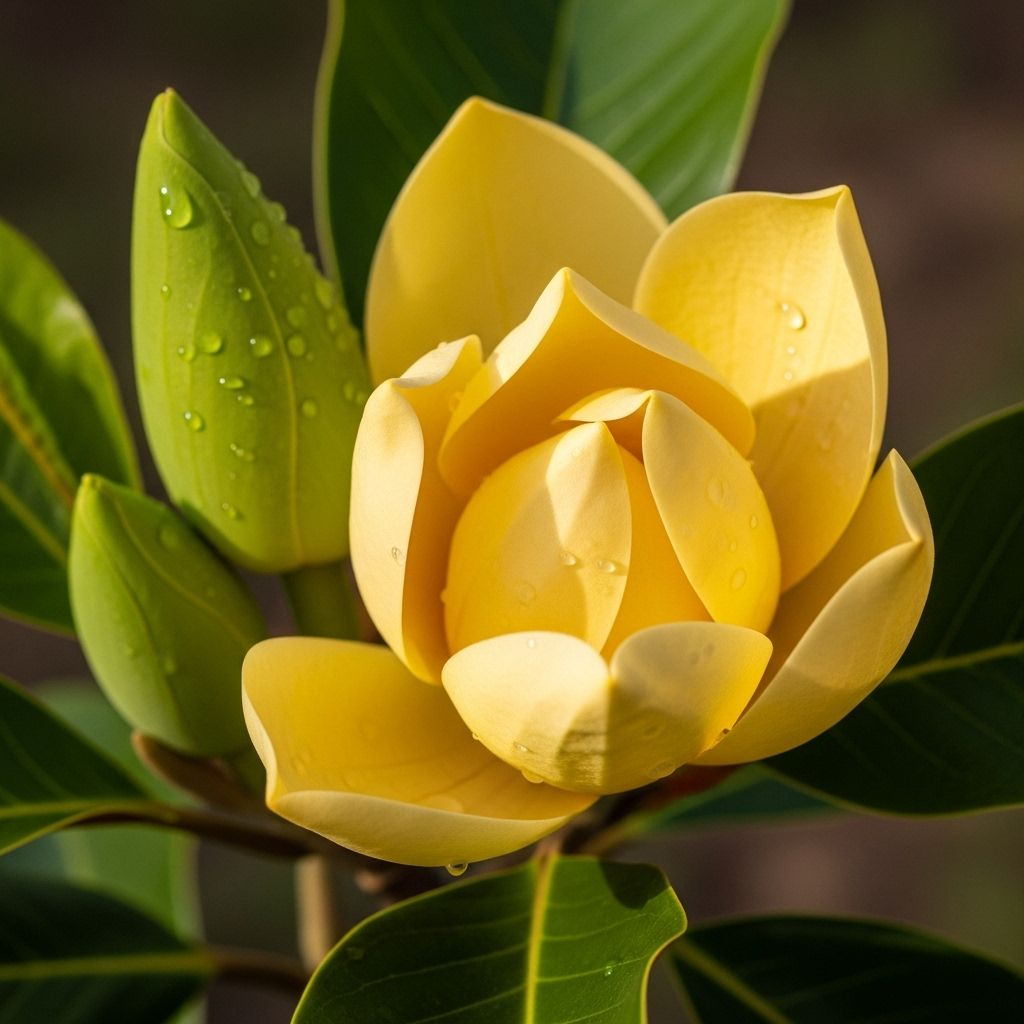Yellow Magnolia Varieties
Bringing reliable hardiness and vibrant blooms to gardens of all sizes.

Image: HearthJunction Design Team
Introduction to Yellow Magnolias
Yellow magnolias are a less common but equally breathtaking alternative to their pink, purple, and white counterparts. These trees are renowned for their vibrant yellow flowers, which can range from pale apricot to rich butter, adding a stunning splash of color to any garden. They are generally hardy throughout the UK and can be seen flowering from March to May, depending on the specific cultivar.
## Characteristics of Yellow Magnolias
Yellow magnolias are highly versatile, suitable for gardens of all sizes due to their variable habit, which can range from large shrubs to trees. They are the result of extensive breeding efforts, particularly at Brooklyn Botanic Garden, where American species like *Magnolia acuminata* were crossed with Asiatic species to enhance cold hardiness, soil tolerance, and aesthetic appeal.
## History of Yellow Magnolias
The development of yellow magnolias involved the pioneering work of women like Evamaria Sperber, Doris Stone, and Lola Koerting, who played a crucial role in hybridization programs. Their efforts led to the creation of several iconic varieties that have become staples in modern gardening.
## Varieties of Yellow Magnolias
Here are some of the most notable varieties of yellow magnolias:
–
Yellow Bird (Magnolia ‘Yellow Bird’)
: This hybrid is a cross between *M. acuminata* var. *subcordata* and *M. x brooklynensis* ‘Evamaria’. It is celebrated for its bright yellow, goblet-shaped flowers that bloom in late spring. The tree is pyramidal when young and matures to a rounded form, reaching heights of 40 to 50 feet. Its foliage turns golden bronze in the fall, providing additional seasonal interest.–
Elizabeth
: Named after Elizabeth van Brunt, this was one of the first yellow flowering magnolias. It features six to nine tepals per flower and is known for its intense color on the first blooms.–
Judy Zuk
: This variety is noted for its intensely colored golden-orange flowers, which are tulip-shaped and upright. It is named after a former president of the Brooklyn Botanic Garden.–
Lois
: A small tree with a wide, round canopy, Lois produces numerous compact, deep yellow flowers. The flowers last longer than those of other varieties, offering a prolonged floral display.–
Daphne
: Offers small, upright, tulip-shaped flowers with a vibrant yellow color, making it another popular choice for gardeners.–
Gold Star and Yellow Lantern
: These varieties are part of the select group of magnolias with yellow flowers, each offering unique characteristics and beauty to gardens.## Benefits of Yellow Magnolias
–
Visual Appeal
: Yellow magnolias add a vibrant splash of color to gardens, providing a striking contrast to other flowering plants.–
Variety and Versatility
: They come in a range of sizes and shapes, making them suitable for both small and large gardens.–
Cold Hardiness and Soil Tolerance
: Many yellow magnolia varieties are bred to be exceptionally hardy and adaptable to different soil conditions, making them easier to care for in various climates.## Care and Maintenance of Yellow Magnolias
Planting
–
Soil Preparation
: Yellow magnolias prefer well-draining acidic soil with a pH between 5.5 and 6.5.–
Sunlight and Water
: They thrive in partial shade to full sun and require consistent moisture, especially during the first year after planting. Pruning
Prune after flowering to maintain shape and promote healthy growth. Avoid pruning during the dormant season to prevent disease.
Pest and Disease Management
– Regularly inspect for pests like aphids and scale. Use organic or chemical controls as needed to prevent infestation.
– Monitor for diseases such as leaf spot and root rot, addressing issues promptly to prevent spread.
## Seasonal Interest
Yellow magnolias not only provide stunning spring blooms but also offer additional seasonal interest:
–
Fall Foliage
: Many varieties, like Yellow Bird, have foliage that turns golden or bronze in the fall, adding a new layer of beauty to the garden.–
Winter Structure
: The trees maintain an attractive form throughout the winter, providing a structural element to the landscape.## Frequently Asked Questions (FAQs)
Q: Are yellow magnolias suitable for small gardens?
A: Yes, depending on the variety, yellow magnolias can be suitable for small gardens. Some varieties, like Lois, are compact and ideal for smaller spaces.
Q: How often should I water my yellow magnolia tree?
A: Yellow magnolias require consistent moisture, especially during the first year after planting. Water them regularly, ensuring the soil does not become waterlogged.
Q: Can I grow a yellow magnolia in a container?
A: Yes, you can grow a yellow magnolia in a container if it is large enough to accommodate the tree’s root system. Ensure the container has good drainage holes and use a well-draining potting mix.
Q: What is the best time to prune a yellow magnolia?
A: The best time to prune a yellow magnolia is right after flowering. Avoid pruning in the dormant season to prevent disease and promote healthy growth.
Conclusion
Yellow magnolias are a captivating addition to any garden, offering a unique blend of beauty, hardiness, and versatility. Whether you are a seasoned gardener or just starting out, these trees provide a rewarding experience with their vibrant flowers and easy care requirements.
References
- https://www.gardensillustrated.com/plants/trees/best-yellow-magnolias
- https://www.epicgardening.com/yellow-magnolia-varieties/
- https://weaverfamilyfarmsnursery.com/blogs/learn-more-about-trees-plants/yellow-bird-magnolia-information
- https://www.scottarboretum.org/yellow-magnolias-2/
- https://www.arboretumwespelaar.be/userfiles/file/pdf/150600_Yellow_Magnolias_Camelbeke_Foster.pdf
Read full bio of Shinta












